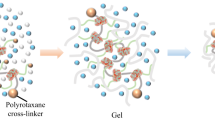Abstract
Exploration of the effect of crosslinking point structures on elastomer properties is significant in the formulation design and performance optimization of elastomers. In the work, we used an equal molar random copolyether of hydroxyl terminated 3,3-bis(azidomethyl)oxetane and tetrahydrofuran (PBT) as a prepolymer, and two PBT elastomers with different crosslinking point structures were prepared by reacting PBT with polyfunctional isocyanate compound N100 and TMP/HDI. FTIR spectrum analysis and swelling tests indicated that N100 crosslinked elastomer S0 and TMP/HDI crosslinked elastomer S4 had an identical chemical crosslinking network. For elastomer S0, hydrogen-bonded urea carbonyl and hydrogen-bonded carbamate carbonyl existed simultaneously, whereas only hydrogen-bonded carbamate carbonyl existed for elastomer S4. Low-field nuclear magnetic resonance measurements analysis indicated that hydrogen-bonding association was among elastomer crosslinking points. Dynamic mechanical analysis showed that the stronger urea carbonyl hydrogen bonding among crosslinks provided elastomer S0 with a lower glass transition temperature (− 37 °C) and a lower modulus loss factor. Elastomer S4 with weaker carbamate carbonyl hydrogen bonding among crosslinking points yielded a higher glass transition temperature (− 30 °C) and higher modulus loss factors. Elastomer S0 presented a higher tensile modulus, and elastomer S4 presented a higher tensile strength and elongation-at-break. These findings provided an experimental and theoretical basis for adjusting mechanical properties of end-crosslinked elastomer by constructing different crosslinking point structure.
Graphical abstract









Similar content being viewed by others
References
Zhai J, Zhao H, Guo X, Li X, Song T (2020) Influence of temperature on mechanical properties of P(BAMO-r-THF) elastomer. Polymers 12:2507
Li B, Zhao Y, Liu G, Li X, Luo Y (2016) Mechanical properties and thermal decomposition of PBAMO/GAP random block ETPE. J Therm Anal Calorim 126:717–724
Zhang C, Li J, Luo Y (2012) Synthesis and characterization of 3,3’-bisazidomethyl oxetane-3-azidomethyl-3’-methyl oxetane alternative block energetic thermoplastic elastomer. Propellants Explos Pyrotech 37:235–240
Zhang Y, Zhao J, Yang P, He S, Huang H (2012) Synthesis and characterization of energetic GAP-b-PAEMA block copolymer. Polym Eng Sci 52:768–773
Osman AF, Edwards GA, Schiller TL, Andriani Y, Jack KS, Morrow IC, Halley PJ, Martin DJ (2012) Structure–property relationships in biomedical thermoplastic polyurethane nanocomposites. Macromolecules 45:198–210
Ning N, Li S, Wu H (2018) Preparation, microstructure, and microstructure-properties relationship of thermoplastic vulcanizates (TPVs): a review. Prog Polym Sci 79:61–97
Zhai J, Guo X, Liu N (2020) Preparation, characterization of propargyl terminal polybutadiene and its crosslinked elastomers properties. Polymers 12:748
Wang S, Liu C, Guo X, Tang G, Gan L, Qi C, Huang J (2017) Effects of crosslinking degree and carbon nanotubes as filler on composites based on glycidyl azide polymer and propargyl-terminated polyether for potential solid propellant application. J Appl Polym Sci 134:45359–45367
Zhang C, Zheng X, Li Z, Cao G, Zhang X, Zhai B (2017) Synthesis and characterization of novel azido polymers: hyperbranched poly-3-azidomethyl-3-hydroxymethyl oxetane. Propellants Explos Pyrotech 42:1037–1043
Deng J, Li G, Xia M, Lan Y, Luo Y (2016) Improvement of mechanical characteristics of glycidyl azide polymer binder system by addition of flexible polyether. J Appl Polym Sci 133:43840–43846
Chen K, Yuan S, Wen X, Sang C, Luo Y (2021) Effect of mixed isocyanate curing agents on the performance of in situ-prepared HTPE binder applied in propellant. Propellants Explos Pyrotech 46:1–13
Zhai J, Jia H, Guo X (2017) Sequence structure, morphology and viscosity behavior of 3,3-bis(azidomethyl) oxetane-tetrahydrofuran random copolyether. Propellants Explos Pyrotech 42:643–648
Sormana JL, Meredith JC (2004) High-throughput discovery of structure-mechanical property relationships for segmented poly(urethane-urea)s. Macromolecules 37:2186–2195
ZhaiJ ZN, Guo X, He J, Li D, Yang R (2016) Study on bulk preparation and properties of click chemistry end-crosslinked copolyether elastomers. Eur Polym J 78:72–81
Patel JP, Hsu SL (2018) Development of low field NMR technique for analyzing segmental mobility of crosslinked polymers. J Polym Sci B56:639–642
Teymouri Y, Adams A, Blümich B (2016) Compact low-field NMR: unmasking morphological changes from solvent-induced crystallization in polyethylene. Eur Polym J 80:48–57
Wojtecki RJ, Meador MA, Rowan SJ (2011) Using the dynamic bond to access macroscopically responsive structurally dynamic polymers. Nat Mater 10:1–27
Zhang C, Hu J, Li X, Wu Y, Han J (2014) Hydrogen-bonding interactions in hard segments of shape memory polyurethane: toluene diisocyanates and 1,6-hexamethylene diisocyanate. A theoretical and comparative study. J Phys Chem A 118:12241–12255
Yilgör I, Yilgör E, Wilkes GL (2015) Critical parameters in designing segmented polyurethanes and their effect on morphology and properties: a comprehensive review. Polymer 58:A1–A36
Król P (2007) Synthesis methods, chemical structures and phase structures of linear polyurethanes: properties and applications of linear polyurethanes in polyurethane elastomers, copolymers and ionomers. Prog Mater Sci 52:915–1015
Yin X, Liu C, Lin Y, Guan A, Wu G (2015) Influence of hydrogen bonding interaction on the damping properties of poly(n-butyl methacrylate)/small molecule hybrids. J Appl Polym Sci 132:41954–91955
Wang W, Lu W, Goodwin A, Wang H, Yin P, Kang NG, Hong K, Mays JW (2019) Recent advances in thermoplastic elastomers from living polymerizations: macromolecular architectures and supramolecular chemistry. Prog Polym Sci 95:1–31
Acknowledgements
The authors are grateful to the National Natural Science Foundation of China (Grant NO.51473022) and the Open Research Fund Program of Science and Technology on Aerospace Chemical Power Laboratory (Grant No. STACPL220201B01) for financial support.
Author information
Authors and Affiliations
Corresponding author
Rights and permissions
About this article
Cite this article
Zhai, J., Pang, A., Ding, T. et al. Effect of crosslinking point structures on properties of polyurethane end-crosslinked PBT elastomers. Iran Polym J 31, 333–341 (2022). https://doi.org/10.1007/s13726-021-00999-6
Received:
Accepted:
Published:
Issue Date:
DOI: https://doi.org/10.1007/s13726-021-00999-6




